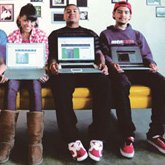Web-Savvy Teens Offer Fresh Take on Tech
When the owners of Malibu, Calif.–based technology resource Shapely Shadow looked into gaining feedback for its latest high-tech software product, they didn’t call on the usual industry veterans. Instead, they went to Venice High School and looked to teen-agers for help.
“They are light years ahead of what we can imagine,” said Roxy Starr, Shapely Shadow’s chief technical officer, adding that most teens know more about technology than anyone over age 30. “They can’t imagine life without multiple electronics,” she said. “It seemed a natural.”
Teens spend as much as 60 percent of their free time online, and much of that time is wrapped up in social networking on sites such as MySpace, Facebook and others.
For Shapely Shadow, which recently rolled out its FastFit 360 fit-collaboration tool, the goal of enlisting high-schoolers was to help the company test the product as well as give the next generation of fashionistas a taste of what the fashion industry is about.
The students are part of Venice High’s Bilingual Business and Finance Academy, which is a three-year program for those who are motivated to get a jump on pursuing their educational and career goals. Many are underprivileged and learned English as a second language.
“The only criteria we had was that they have a MySpace account,” said Starr, explaining that there is a heavy collaboration aspect to the semester-long project, which began in March.
FastFit, which launched in November 2008, is an online collaboration tool that uses digital imagery to capture sample garments on a fit model or dress form. The end result ends up looking like a video that can be rotated and manipulated by the users—usually a design team and an offshore factory—to capture inconsistencies in fit. The aim is to eliminate the number of iterations that often take place as well as the costly shipping of samples back and forth between the designers and factories.
Other unseen benefits have been realized as well, Starr said.
“What’s interesting about this is that we received a call from a client who said that because of the recent swine flu outbreak, the only way they could communicate with their Mexican suppliers is through FastFit. They don’t even want to open the packages [containing samples].”
The students hook up to FastFit via the Internet and collaborate with others twice a week on garment examples. Starr and company Principal Ilona Foyer often call FastFit the “MySpace of fashion.”
During the sessions, students act as retailers and suppliers. They can simultaneously view a sample garment and get each other’s observations on how they fit.
In real-life scenarios, FastFit can reduce fit sessions to as low as one take. As the average retailer or manufacturer conducting four to six iterations of each garment, the return on investment comes fast, she said. The students also benefit. “They learn how the supply chain works and get an understanding of what sourcing is all about. The interesting part of this is that most of them didn’t have any idea of how a garment gets on a rack all the way from China. Now they are actually reading the tags,” Starr said.
The students consider the sessions more fun than work.
“I look forward to coming to work every Tuesday and Thursday. It reminds me of using my MySpace because we can comment on each other’s images and upload photos,” said student Ava Lankford.
Another student, Marvin Merino, said he most likes detecting fit issues.
“It made sense to look for young talent and technology-savvy students to help us test while sharing our knowledge,” concluded Starr.
For more information, visit www.shapelyshadow.com.
























